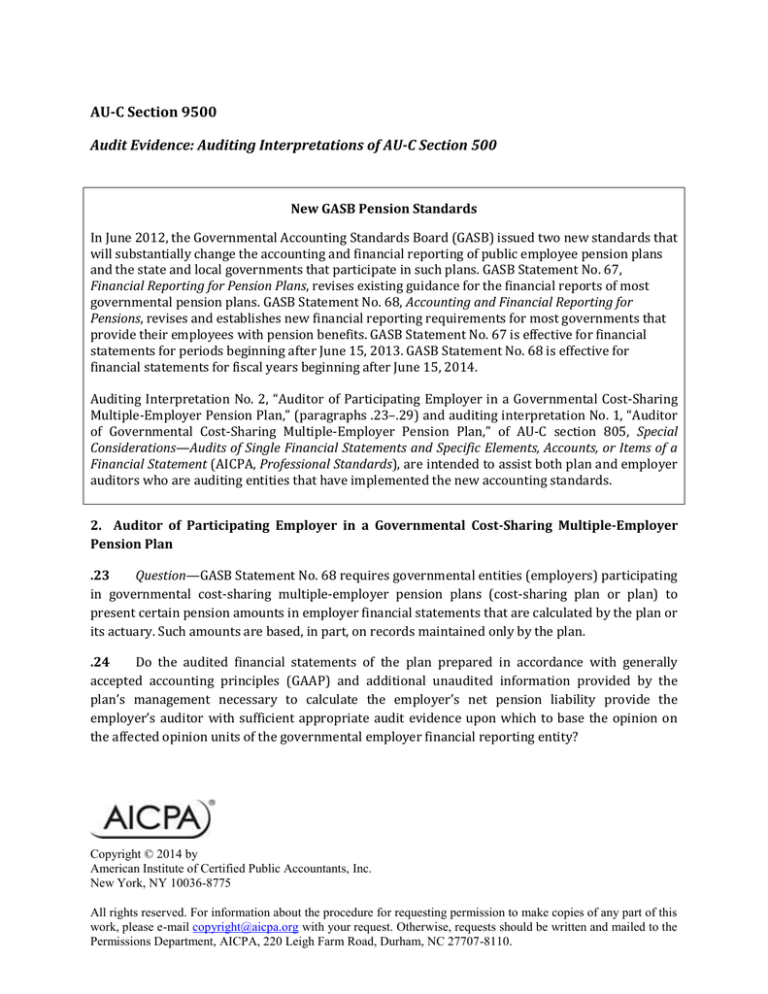
AU-C Section 9500
Audit Evidence: Auditing Interpretations of AU-C Section 500
New GASB Pension Standards
In June 2012, the Governmental Accounting Standards Board (GASB) issued two new standards that
will substantially change the accounting and financial reporting of public employee pension plans
and the state and local governments that participate in such plans. GASB Statement No. 67,
Financial Reporting for Pension Plans, revises existing guidance for the financial reports of most
governmental pension plans. GASB Statement No. 68, Accounting and Financial Reporting for
Pensions, revises and establishes new financial reporting requirements for most governments that
provide their employees with pension benefits. GASB Statement No. 67 is effective for financial
statements for periods beginning after June 15, 2013. GASB Statement No. 68 is effective for
financial statements for fiscal years beginning after June 15, 2014.
Auditing Interpretation No. 2, “Auditor of Participating Employer in a Governmental Cost-Sharing
Multiple-Employer Pension Plan,” (paragraphs .23–.29) and auditing interpretation No. 1, “Auditor
of Governmental Cost-Sharing Multiple-Employer Pension Plan,” of AU-C section 805, Special
Considerations—Audits of Single Financial Statements and Specific Elements, Accounts, or Items of a
Financial Statement (AICPA, Professional Standards), are intended to assist both plan and employer
auditors who are auditing entities that have implemented the new accounting standards.
2. Auditor of Participating Employer in a Governmental Cost-Sharing Multiple-Employer
Pension Plan
.23
Question—GASB Statement No. 68 requires governmental entities (employers) participating
in governmental cost-sharing multiple-employer pension plans (cost-sharing plan or plan) to
present certain pension amounts in employer financial statements that are calculated by the plan or
its actuary. Such amounts are based, in part, on records maintained only by the plan.
.24
Do the audited financial statements of the plan prepared in accordance with generally
accepted accounting principles (GAAP) and additional unaudited information provided by the
plan’s management necessary to calculate the employer’s net pension liability provide the
employer’s auditor with sufficient appropriate audit evidence upon which to base the opinion on
the affected opinion units of the governmental employer financial reporting entity?
Copyright © 2014 by
American Institute of Certified Public Accountants, Inc.
New York, NY 10036-8775
All rights reserved. For information about the procedure for requesting permission to make copies of any part of this
work, please e-mail copyright@aicpa.org with your request. Otherwise, requests should be written and mailed to the
Permissions Department, AICPA, 220 Leigh Farm Road, Durham, NC 27707-8110.
.25
Interpretation—No. GASB Statement No. 67 requires only the disclosure of the collective net
pension liability for all participating employers in GAAP financial statements of cost-sharing plans,
not each employer’s proportionate share of the collective net pension liability. Further, GAAP does
not require the plan to present deferred outflows of resources or deferred inflows of resources by
category, pension expense, or each participating employer’s share of collective pension amounts.
Unaudited information provided by the plan’s management to the employers to support allocations
or pension amounts that has not been subjected to further audit procedures beyond those
performed in the audit of the basic plan financial statements would not constitute sufficient
appropriate audit evidence to support the relevant assertions in the employer’s financial
statements related to the pension amounts, including required disclosures.
.26
Absent additional audit evidence from the cost-sharing plan (for example, auditor’s
opinions on the schedule of employer allocations and certain key elements including net pension
liability, total deferred outflows of resources, total deferred inflows of resources, and total pension
expense in a schedule of pension amounts), the employer auditor would not likely be able to
accumulate sufficient appropriate audit evidence to support the pension amounts and disclosures
in the employer’s financial statements. When pension amounts are material to one or more
applicable opinion units of the employer’s financial statements and the auditor is unable to obtain
sufficient appropriate audit evidence to conclude that the financial statements of those opinion
units are free from material misstatement, the auditor should modify the audit opinion pursuant to
AU-C section 705, Modifications to the Opinion in the Independent Auditor’s Report (AICPA,
Professional Standards).
.27
Question—A plan has engaged its auditor to audit and report on the schedule of employer
allocations and certain key elements including net pension liability, total deferred outflows of
resources, total deferred inflows of resources, and total pension expense in a schedule of pension
amounts, as described in the AICPA’s State and Local Governments Expert Panel white paper
Governmental Employer Participation in Cost-Sharing Multiple-Employer Plans: Issues Related to
Information for Employer Reporting. May an employer auditor use the plan auditor’s report as
evidence for the audit of the employer’s financial statements?
.28
Interpretation—Yes. The employer auditor is solely responsible for the audit of the
employer’s financial statements and, therefore, is responsible for determining the sufficiency and
appropriateness of audit evidence necessary to reduce audit risk to an appropriately low level.
Nevertheless, the employer auditor may use the plan auditor’s report on the schedules as evidence
that the pension amounts allocated to the employer and included in the employer’s financial
statements are not materially misstated.
.29
Before using the report of the plan auditor as evidence, the employer auditor should
evaluate whether the plan auditor’s report and accompanying schedules are adequate and
appropriate for the employer auditor’s purposes. For example, the employer auditor may review
the plan auditor’s report and any related opinion modifications and assess other matters discussed
in the report. Additionally, the employer auditor should evaluate whether the plan auditor has the
necessary competence and independence for the employer auditor’s purposes. Further, the
employer auditor has a responsibility to verify and recalculate amounts specific to the applicable
employer, including the employer amount used in the allocation percentage (that is, the numerator
of the calculation), to recalculate the allocation percentage for the employer, and to recalculate the
pension amounts allocated to the employer based on the allocation percentage.
[Issue Date: April 2014.]
